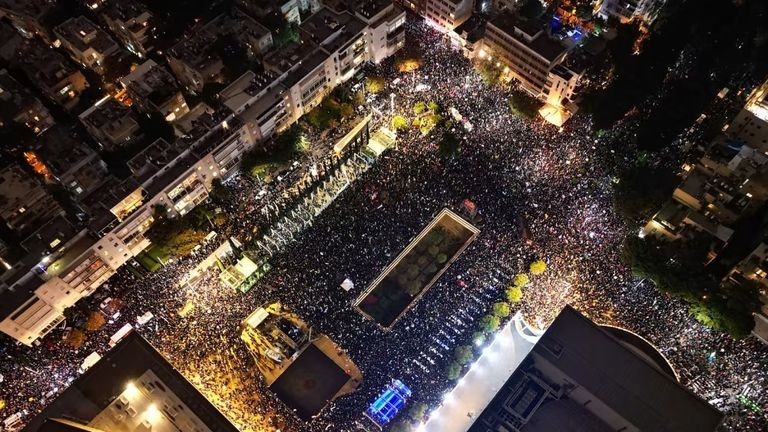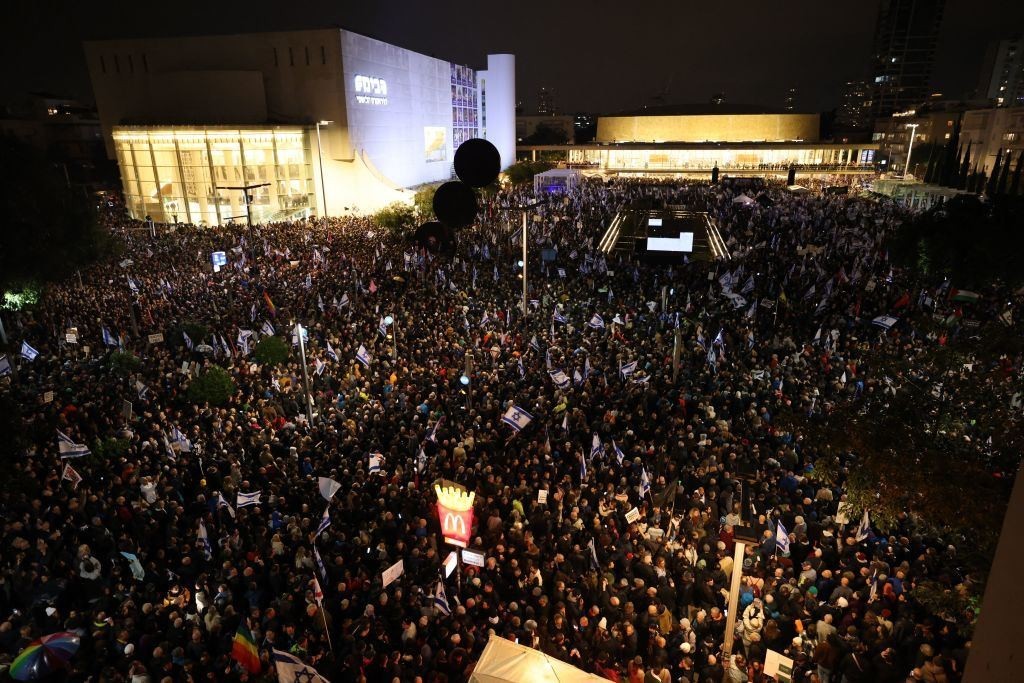On Saturday evening, several demonstrations against the new Israeli government, formed by Likud leader Benjamin Netanyahu along with Israeli right-wing parties, were held after almost two weeks of its endorsement. Those demonstrations reject the Israeli occupation's policies that reduce the powers of the Supreme Court and prevent it from deciding on the decisions issued by the Israeli Knesset and government, as well as prevent it from appointing judges and the president of the Supreme Court. This thus was considered as a disruption of democracy and a coup against it.
Tel Aviv hosted the largest demonstrations and mobilized more than 100 thousand Israeli residents, who gathered in Habima yard despite the rain. A number of left and centre leaders, most importantly Former Prime Minister Ehud Barak, and Former Minister of Defense Benny Gantz, participated in demonstrations. In addition, other protests were held in Hurif field in Haifa, in front of President Isaac Herzog and in front of Minister of Justice Yariv Gideon. Therefore, this has constituted an unprecedented, exceptional mobilization witnessed by the occupation entity against a current Israeli government.
Such protests are an actual translation of the sharp polarization faced by the Israeli society between the right and left in the meantime, as well as the conflict over the keys of ruling and control, in a way that includes the political, judicial and military institutes and the likes.

Analysis and Reading of the Scene
• The demonstrations that were held on Saturday, to a certain extent, put pressure on Netanyahu's government to reduce its political greed in order to control the entire system of governance in the occupation entity and achieve the wishes of partners in the coalition. However, they remain inconclusive amid the coalition's consistency and unity of visions and goals.
• Despite the great protest held against Netanyahu, it still does not pose threat to the continuity of the Israeli government. Any pressures from outside the political system will not be effective as mush as if they were from the inside.
• Benjamin Netanyahu adheres to the achievement of the demands of his allies in the religious rightest parties, even though he realizes their seriousness, in order to serve his political interests represented in protecting him from any charges brought against him.
• The participation of important leaders in the anti-Netanyahu protests constitutes an element of power for such protests, in light of Netanyahu's government's accusations against the protestors and their goals.

Situation Report: based on the abovementioned analysis and reading of the scene, following are the expected scenarios:
1. The protest steps might fail to affect the form of the current rightest government led by Netanyahu, the political greed and vulgar domination over institutes through legal and legislative means might continue, and the superiority state of the Knesset might be exploited to pass on its extreme program. This scenario is supported by the compatibility between the components of Netanyahu's government in the visions and goals.
2. Protests might be able to limit the rightest currents' ability to extend influence and exert programs that affect the official institutes in the occupation entity. This scenario is strengthened by Netanyahu and his government's need to reduce the opposition overwhelming the streets.
3. The protest steps of the left and centre parties might succeed to affect the resolutions and programs of the Israeli occupation government, led by Netanyahu, and to maintain a reasonable strategy of governance that preserves the general form of the Israeli political system without affecting its components. What enforces this scenario is that the powerful protests might constitute an element of pressure on the government.
In general, all scenarios are achievable, with preference for the first scenario and its possibility to develop to the second one in case the protests were more powerful and effective.





